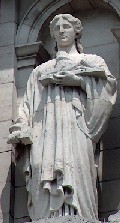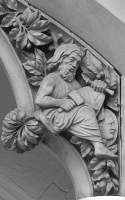
Allegorical statues of Sculpture are less common than of Painting, but by no means infrequent. We have two main types. The first type is an allegorical female, with a piece of sculpture, a sculptor’s mallet, or often both. The example at the top of this page, by Lanteri on the front of the V & A, is holding a model of the Sphinx, particularly emblematic as one of the largest single works of sculpture, and a square mallet; the seated figure below left, by John Henning Jr, I believe, has a bust of Athena on a small stool. That below right holds some indistinguishable figurine. We see that our figure of Sculpture wears Classical costume in all three cases, and this is typical and appropriate, given the unsurpassed skill of the ancient Greeks in this art.
Our next example, below left, has our allegorical female holding an instantly recognisable statue of Dionysus from the Elgin marbles in the British Museum, and wearing a wraparound costume reminiscent of the little terra cotta figures from Tanagra. Below right is an angelic girl with a standing male figure. Rather than full robes, she wears the thin chiton familiar from countless Greek nereids.
The second allegorical type for Sculpture is a male figure. The example below left is comparable to the female figures of sculpture; he stands, wearing light classical garb, holding a mallet and with a Homeric bust ona short pillar. A. G. Lawson made this work. Below right we have a figure shown as an actual sculptor, in this case some medieval monk rather than a Classical personage, because he is on a Gothic arch, and a mixing of styles would normally be avoided. He is seated, holding both mallet and chisel, and tucked behind his leg is a portrait roundel of some Victorian figure, perhaps Albert. His arm, thick hands, and weatherbeaten face, show a practitioner rather than purely a figure of allegory.

 Male allegorical figures of Sculpture.
Male allegorical figures of Sculpture.
Here is a rare example of a juvenile sculptor, a cherubic figure actually in the act of hitting a chisel the bust of some youth he is carving, standing on a low stool. I cannot warm to figures such as this, no matter how skilfully rendered.
Our final example is another female. It is the work of the eminent Sir Richard Westmacott, and is one of the figures on the pediment of the British Museum, and has the familiar accoutrements of sculptor’s mallet and a piece of sculpture, this time a bust on a plinth rather than a stool. Yet it seems almost disrespectful to the art of sculpture, as our allegorical figure rests her elbow on the brow of the bust.
Back to Allegorical sculpture - R // Onward to Allegorical sculpture - T // Full Alphabet of Allegorical sculpture
Sculpture in London // Sculpture in England // Sculptors
Visits to this page from 3 June 2012: 8,392